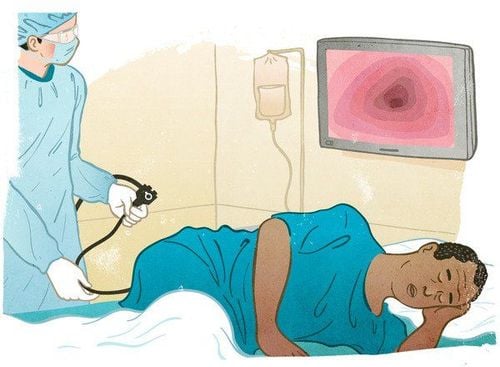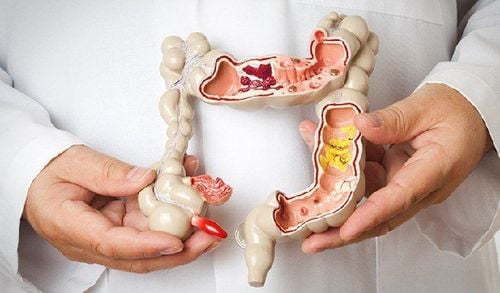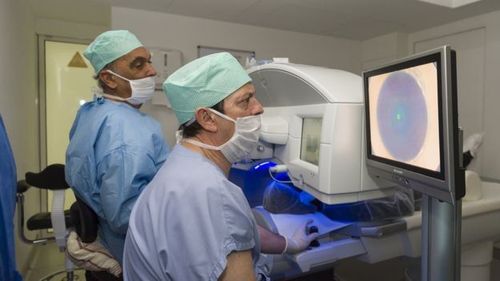This is an automatically translated article.
The article was written by Specialist Doctor I Dong Xuan Ha - Digestive Endoscopy Doctor, Department of Medical Examination and Internal Medicine - Vinmec Ha Long International General Hospital.
Digestive tract diseases are a common group of diseases, especially digestive tract diseases. Anyone with more than once in their life suffering from mild to severe even very serious digestive tract problems.
1. Advantages of gastrointestinal endoscopy
Other means of examination such as X-ray, ultrasound, multi-sequential computed tomography, magnetic resonance imaging, even Nuclear medicine, etc... also cannot survey the lesions in detail. lumen of the gastrointestinal tract and is often only detected in cases where the disease has become too severe.
Gastrointestinal endoscopy including colonoscopy has overcome the above disadvantages. Colonoscopy is a way that the doctor will insert a specialized instrument into the rectum of the colon through the anus, or from the mouth through which the doctor can "see" directly but the damage in the digestive tract. .
2. Colonoscopy method
Hard tube colonoscopy: A hollow, rigid tube about 30cm long is inserted through the anus into the rectum, the doctor will directly observe the intestinal lumen with the naked eye, but the field of view is narrow, with many complications. Capsule colonoscopy with camera: Capsules are swallowed orally, through the esophagus, to the stomach and then down the small intestine and colon by peristalsis. However, it does not observe carefully the desired lesion, does not biopsy nor intervene.

Virtual endoscopy: Simulation of the lumen through multi-slice computed tomography. Colonoscopy with flexible bronchoscope: This is a great advancement of medical technology. The doctor will insert a flexible endoscope, with a camera on the end, into the colon. Thereby the doctor will observe in detail the lesions in the colon lumen. This endoscope also has its own channels to be able to put more specialized instruments into the colon lumen for procedures such as biopsy of lesions, emergency intervention, or therapeutic intervention (Polypectomy, mucosal resection, etc.). early cancer treatment)... However, this method also has certain inconveniences, often causing pain to patients during colonoscopy, perforation, bleeding... So colonoscopy Anesthesia was born to overcome the above weaknesses.
3. What is anaesthesia colonoscopy?
Anesthesia colonoscopy is that the patient is anesthetized during the procedure. The doctor will inject the patient with a mild anesthetic to make the patient "sleep" and then start performing the endoscopic technique.
The patient will lie still during the colonoscopy without feeling any pain or discomfort, after the end of the endoscopy about 5 minutes, the patient can be completely awake, eating as usual.
This method also reduces a lot of unnecessary complications because the initiative will belong to the doctor, not related to the patient's muscle contractions and struggles.
But the biggest benefit of endoscopic anesthesia is that when the patient is still, the doctor can find and observe carefully the lesions, biopsies or perform interventional procedures in the most accurate way.

4. Colonoscopy procedure
After asking about symptoms, medical history, personal history, family and related factors, a thorough and careful clinical examination, doing previous tests such as blood test, electrocardiogram , abdominal ultrasound, X-ray examinations... exclude contraindications to endoscopy such as acute myocardial infarction, suspected hollow organ perforation or recent surgery.. The doctor will weigh the benefits and give indications. colonoscopy.
If the colonoscopy is under anesthesia, the patient will be examined before anaesthesia, if there are no problems, the patient will be instructed to clean the colon before colonoscopy.
Depending on the specific case, there are different ways to clean the colon such as enemas, enemas or oral pills.. Taking Fortrans is the most popular cleansing method.
After cleaning the colon, the patient will have a laparoscopic procedure, this is a difficult procedure that requires careful training. without anesthesia.
Depending on each patient and diagnostic or interventional procedure, the length of an endoscopy varies, with experienced doctors, the diagnostic endoscopy takes place very quickly.. but not less. 20 minutes to avoid missing lesions.
After that, depending on each patient, each indication for diagnostic or interventional endoscopy, symptoms after endoscopy, the patient can go home immediately or have to be monitored from hours and hours to several days with interventional procedures. high risk of perforation or secondary bleeding.
Finally, the doctor will explain to the patient the problems they are having and then agree with the patient on how to best solve those problems.

5. Possible complications of colonoscopy
Colonoscopy complications can occur in any procedure of the colonoscopy from mild to severe, but it is completely possible to control these complications to the lowest level with a thorough examination. careful endoscopic procedures and highly skilled endoscopists.
Possible complications such as:
During examination:
Contraindications such as myocardial infarction, hollow organ perforation, cannot be excluded. The risk of complications such as diverticulitis cannot be predicted. causing perforation during laparoscopy, old surgical scars causing adhesions, large dissection of the abdominal aorta... During colon cleansing:
Injury to the colon when enema or oral medication is taken... During the procedure procedure: a common complication is perforation or bleeding. During anesthesia:
Due to lack of pre-anesthesia examination, but sometimes also because patients do not inform the doctor about their problems, especially patients often hide their history of using alcohol and drugs. arouse.
During follow-up:
Ignore or not detect the symptoms of a stroke.
Please dial HOTLINE for more information or register for an appointment HERE. Download MyVinmec app to make appointments faster and to manage your bookings easily.














